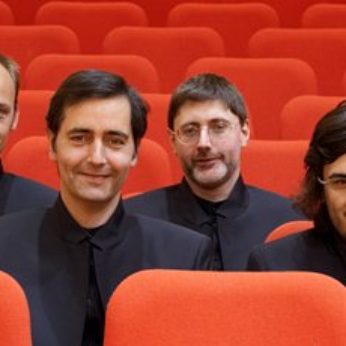Composer: Mieczyslaw Weinberg (b. 1919 - d. 1996)
Performance date: 01/07/2013
Venue: St. Brendan’s Church
Composition Year: 1945
Duration: 00:24:25
Recording Engineer: Damian Chennells, RTÉ lyric fm
Instrumentation: 2vn, va, vc
Instrumentation Category:String Quartet
Artists:
Quatuor Danel (Marc Danel, Gilles Millet [violins], Vlad Bogdanas [viola], Guy Danel [cello]) -
[quartet]

The date of this composition
is important to notice. Weinberg was a Polish-Jew, born in
1939 by fleeing the Nazi occupation in which the rest of his family were
slaughtered. The Soviets took him in, completed his musical education and he
settled in
with Shostakovich as a mentor. By 1945, the Red Army, to whom Weinberg owed his
life, was in
but the wartime scars cannot have healed.
He is inevitably
compared with Shostakovich for the two became close friends and their music
trod similar paths with a clear two-way exchange of ideas. Shostakovich tends
to go for the knock-out blow, those devastating scherzos and the almost
unbearable slow movements, while Weinberg, especially in this Quartet, creates
similar effects with more subtlety, even delicacy. They both however shared an
anarchic sense of humour.
The laid-back
opening of this wonderful Quartet is a case in point, a wisp of theme is
announced, the texture spare and unadorned, only gradually is its sadness made
unambiguous as the textures expand. The end returns to the beginning. The Humoreska is opened by a simple melody
with a pizzicato accompaniment that is gradually developed and explored, its
folk-like tune changing its skin for something darker and deeper before working
edgily back towards the earlier simplicity and a highly ambiguous coda.
The Scherzo is a
mini tornado, played at outrageous speed and gone in a flash. The solo first
violin leads the way through the muted colours of the fourth movement, a quiet,
genlt movement to atone for the outspoken Scherzo. The final movement opens
deceptively with a lover serenading at the window of the beloved and once again
the seeming simplicity of a love-song is overwhelmed by outside forces, leading
to the most terrifying outburst in the entire work. Nothing is as it seems and
darkness awaits, to be followed by internal disintegration and slow collapse,
the final cadence breathtaking.
Copyright © 2024 West Cork Music. All rights reserved.
Designed and developed by Matrix Internet